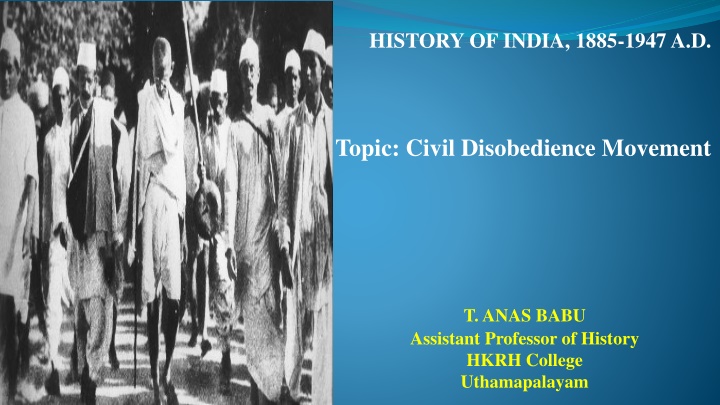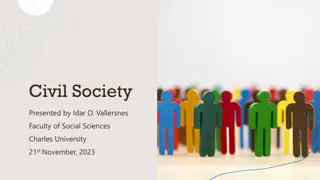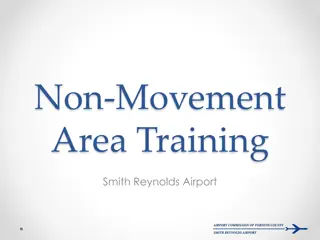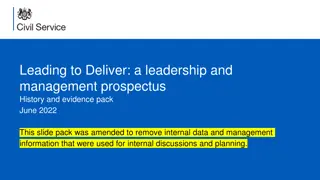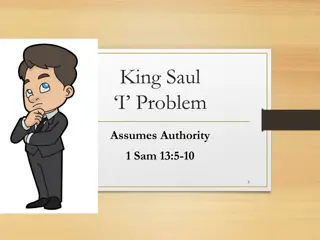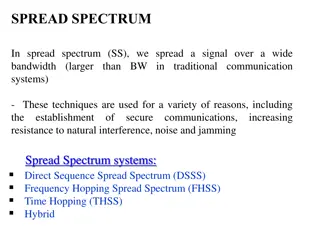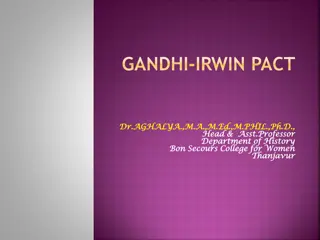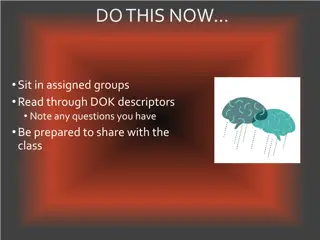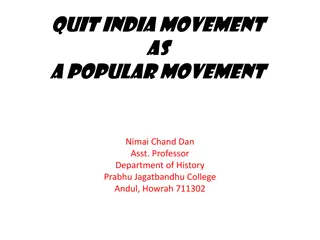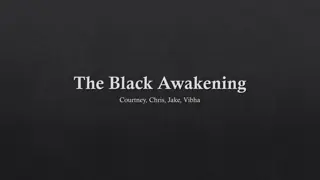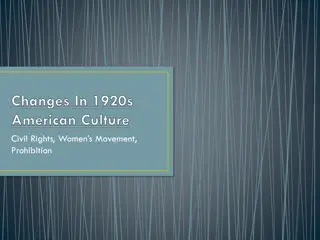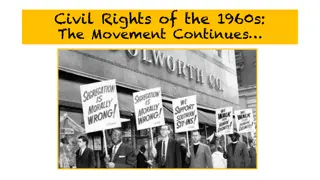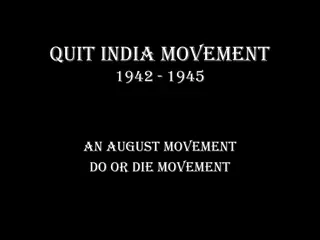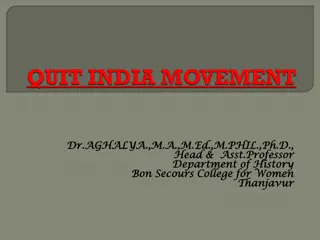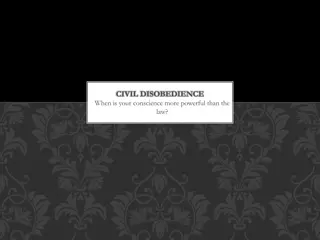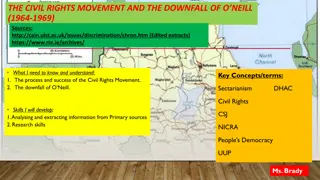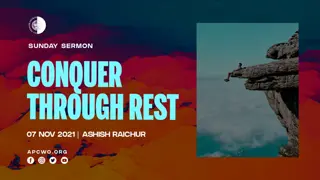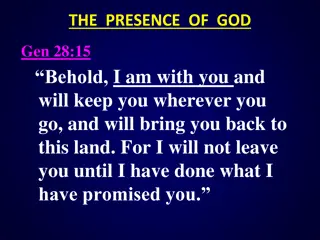Civil Disobedience Movement in India: Causes, Dandi March, and Spread
The Civil Disobedience movement led by Mahatma Gandhi played a pivotal role in India's freedom struggle against British rule. Learn about its causes including the Simon Commission, Dandi March, and the widespread impact of the movement across the nation.
Download Presentation

Please find below an Image/Link to download the presentation.
The content on the website is provided AS IS for your information and personal use only. It may not be sold, licensed, or shared on other websites without obtaining consent from the author.If you encounter any issues during the download, it is possible that the publisher has removed the file from their server.
You are allowed to download the files provided on this website for personal or commercial use, subject to the condition that they are used lawfully. All files are the property of their respective owners.
The content on the website is provided AS IS for your information and personal use only. It may not be sold, licensed, or shared on other websites without obtaining consent from the author.
E N D
Presentation Transcript
HISTORY OF INDIA, 1885-1947 A.D. Topic: Civil Disobedience Movement T. ANAS BABU Assistant Professor of History HKRH College Uthamapalayam
Civil Disobedience Movement Introduction The Civil Disobedience movement started by Mahatma Gandhi in the course of India s freedom struggle It aims to disobey the British Government It was a active and strong refusal Movement to Disobey certain laws, demands or commands of British government It was a mass nonviolent resistance Movement was a significant
Causes for Civil Disobedience Movement The Simon Commission (1927) - In 1927 British Government appointed a committee known as Simon Commission, headed by John Simon to look the working of Government of India Act, 1919 and bring new constitutional reforms. -Indians opposed the commission because no Indian as a member of it. 2. Protest against the arrest of Revolutionaries - In 1929, Hindustan Socialist Republican Army (HSRA) leaders Baghat Singh, Rajkuru and Sukhdev threw bombs in the LegislativeAssembly of Lahore and they were arrested 3. Demand for Poorna Swaraj - 1929, Lahore Session of the I.N.C. set its goal as Poorna Swaraj 1.
Dandi March or Salt Satyagraha (1930) Gandhi submitted Eleven point ultimatum to the British, but after no response he launched Civil Disobedience Movement. The Civil Disobedience Movement was started with the Dandi March also called as Salt Satyagraha. Gandhi started from Sabarmati Ashram, Ahmedabad, on March 12, 1930 along with 78 followers and reached a small coastal village at Dandi after walking 390 k.m. in 24 days Arriving on 6thApril, Gandhi picked up a piece of salty sand and violated the salt law of the British
With this Gandhi inaugurated Civil Disobedience Movement. Earlier, the British monopolized the production of salt by laws Then Gandhi encouraged people to boycott salt tax and make salt by their own Salt was a symbol of the unwillingness of the people to live under the British Gandhi was arrested on May
Spread of the Movement Soon after Disobedience Movement spread all over the country The people started -boycotting foreign goods - Organizing rally s and meetings - Producing salt etc. Salt Satyagraha, the Civil Gandhi s
Vedaranniyam Satyagraha In Tamil Nadu, Rajaji (C.Rajagopalachari) led a similar Salt Satyagraha called Vedaranniyam Satyagraha He started from Trichy on April-13, along with 150 volunteers and reached at coastal Vedaranniyam in Tanjavur district (presently at Nagapattinam) after traveling 240 k.m. Then he produced salt by violating British salt laws
InAssam Satyagarahis walked to Bengal for making salt At North-West frontier, the movement was led by Khan Adul Gaffar Khan, popularly known as frontier Gandhi. He organised Red Shirts (Kudai Khidmadgars) At Kerala, the movement was led by K. Kelappan The protest was strong all over India Huge demonstrations was held in Calcutta, Madras, Bombay, North West Frontier etc. Along with Salt Satyagraha the people also carried non- payment of land and other taxes Women, students, workers, merchants, soldiers etc. were actively participated in the movement The movement spread all over India.
Response of the Government At the beginning government did not paid any methods to stop the movement But, with the fast spreading of the movement, they started to arrest the people British arrested many national leaders and people, who violated the Salt laws and participated in the movement 90,000 people were arrested including many Congress leaders Gandhi was arrested in May British followed Lathi charges and firings was carried against the unarmed people
The British soon realized to end the movement They invited Congress for the First Round Table Conference in 1930. But Congress was not accepted Gandhi- Irwin Pact (1931) Gandhi was released from Jail in Jan-1931 To end the Civil Disobedience Movement, British Viceroy, Lord Irwin initated talk with Gandhi On Feb-1931, Viceroy and Gandhi held a meeting at Delhi called Gandhi-Irwin Pact
In the meeting, British and Gandhi agreed on: 1. Release all political prisoners except Baghat Singh, Rajguru and Sukdev 2. Right to make salt in coastal villages for personal consumption (not for sale) 3. Right to peaceful protest Gandhi, on behalf of the Congress agreed to the suspension of the Civil Disobedience Movement Mahatma Gandhi finally suspended the Civil Disobedience Movement in 1933 and asked the people for Individual Satyagraha.
THANK YOU THANK YOU
